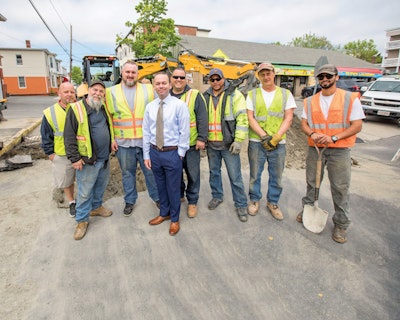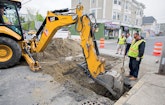
Sewer & Water Department workers Eddie Santiago (left) and Frank Rapisardi move a length of polyvinyl chloride pipe into place to replace a crushed drainage pipe while Frank Condo readies himself in the pit.
All utilities face challenges. Some challenges are a lot bigger.
Imagine for a moment being a 29-year-old professional engineer overseeing an ill-equipped and undermanned sewer department in the state’s poorest community, with nearly century-old sewer and water pipes needing tens of millions of dollars of repair and the Environmental Protection Agency and Department of Justice tapping you on the shoulder about Clean Water Act violations.
Welcome to the world of Brian Pena, water and sewer commissioner for the city of Lawrence, Massachusetts, a Merrimack River Valley town 25 miles north of Boston. Pena started at City Hall on a Tuesday in May 2014 and two days later was welcomed to work by a Department of Justice consent decree. “I didn’t see it coming,” he acknow-ledges. But neither was he particularly surprised.
As a former engineering consultant to the city for the firm of Woodard & Curran, Pena was very familiar with Lawrence’s sewer and water situation so he knew what he was getting into when he joined the city’s executive team. “The EPA long knew there was an issue in the city — a lack of investment in infrastructure. The city was very reactive. When the EPA sent out a number of people to observe the work of the department, they got to witness how the city reacted to things. They were not impressed.”
Now they might be. Pena, along with Carlos Jaquez (director of Public Works) and the city administration of newly elected Mayor Daniel Rivera, have begun to turn things in another direction. Pena credits Rivera with being committed to clean water and strengthened infrastructure that will enhance economic development and the community’s quality of life. All three are proponents of proactive infrastructure supervision.
This change in mindset became immediately clear to Justice Department lawyers when they sat down to negotiate with the city. “When we had the first meeting with the EPA and Justice people, we were excited to show them all we had done,” Pena says. “We had to expand what we were doing quite a bit, but we had planned to do that anyway. We just relayed to city officials that we needed to do it quicker.”
Initial evaluation
Before 2014, the system’s problems were not unknown to community leaders. When water and sewer pipes have been in the ground for 97 years and repairs are constantly being made across the system, the problem and solution are obvious: Old pipes need replacing. Yet for decades the city had banked on the pipes not failing until more city funds were available. In 2014 the need to repair and replace had become critical. Putting repairs off for another day was no longer a viable fiscal or maintenance approach.
“When I came aboard I pushed for proactive maintenance despite the evident cost of that approach,” Pena says. “Doing nothing until failure occurs is a double-edged sword. But securing $20 million to address the issue was an obstacle. The city would save money in the long run, but the upfront money was still an obstacle.”
At the heart of the city’s new philosophy is a commitment to identify problematic situations before they become critical. In the fall of 2013, a cursory Woodard & Curran evaluation of the city’s sanitary sewer administration concluded that Lawrence kept poor records of a derelict maintenance regime and had no long-term plan for fixing things. The firm was hired to scrutinize a cross section of the system and, from that, develop a systematic and systemwide fix.
The consulting firm’s engineers studied flow, inspected manholes, ran inspection cameras through lines, and performed other testing. This evaluation was well under way when the consent decree was served. Four years later, the city has sent cameras through 300,000 linear feet of pipe, conducted 3,500 certified manhole inspections, and extensively smoke-tested the system. Engineers are on track to inspect the remaining 430,000 linear feet of pipeline over the next five years.
But inspections and evaluations don’t patch leaks. With inspection data in hand, Lawrence officials secured funding from a Massachusetts low-interest revolving fund and bid out repair work. The money largely is being spent on CIP lining of pipes.
So far, $9 million in repair work has been completed in two contracts. Approximately $10 million more is being done this summer. In some places, spot repairs were necessary before pipes could be lined. In all cases, contractors were able to access the city’s pipe systems through manholes, eliminating excavations and the ensuing traffic congestion.
“CIP repairs have a smaller footprint, which helps keep roads open and traffic flowing. That’s huge for our community of 80,000 people and 50,000 vehicles,” Pena says.
Finding savings
Green Mountain Pipeline Services is a CIPP Corp. licensee and inserted liners constructed of Applied Felts material containing Interplastic resin. The steam generator used to push the liner into place was fabricated by Green Mountain itself and employs Clayton Industries boilers. Aries Industries cameras are utilized to inspect the work.
Woodard & Curran engineers have tracked the relative costs of this project over the last three years using Innovyze InfoMaster software. The figures are telling. When the city used the conventional emergency repair method — excavating dirt to lay bare a failed pipe, fixing it, and covering it up again — it spent an average of $760 per linear foot of repaired pipe. When employing CIPP technology, the repair cost per linear foot of pipe was $174.
The cost of contracting with Woodard & Curran to manage the repair process and to inspect and smoke-test cost $3 per linear foot, and the consultant’s management of the work has cost the city 97 cents per foot. In other words, to date, Lawrence has saved itself almost $600 for each foot of inspected and repaired pipe.
Rather than randomly patching pipes as leaks erupt, the money is being spent to rehabilitate entire sections of still-functioning pipe. This more substantial upgrade puts the city in a better position to manage its future economic development. “That has always been one of the selling points,” Pena says.
Making progress
The city is located near two major highways and, with three rivers intersecting the city limits, has more than enough water for residential and commercial use. But the infrastructure was problematic. “We always have made the point that Lawrence has the infrastructure to support expansion, and now we are in an even better position to do that.”
Not that the municipality’s upgrade is anywhere near complete. The CIPP work is proving its value, but there still is a lot of work to be done. Fifty-one of 138 miles of sewer lines — two-thirds of which are sanitary/stormwater combinations — have been inspected. Cameras are being run through another 22 miles this year. That still leaves 65 miles of pipe waiting to be inspected. (Not to mention 154 miles of century-old water pipe, which the city also is carefully monitoring.)
Given all that, the sewer and water department cannot afford to proceed without a plan in place. So, it has prioritized repairs according to levels of urgency:
- Failed
- Likely to Fail
- Reported Overflows
- Paving/Infrastructure Street Work Already Scheduled.
In addition, engineers consider stormwater quality issues, the presence of critical facilities such as hospitals, and so on. This matrix of criteria is fed into a computer program to generate a priority list for the engineers.
Even if all goes as planned and the relative integrity of the entire system is mapped and repaired according to these criteria, the work isn’t done. A second round of inspections will be launched — this time with lower tolerances for what is acceptable. This will establish a pattern of regular inspection over two- or three-year intervals. In other words, the city has learned its lesson.
“I feel we have definitely learned that doing nothing is not, at the end of the day, a good approach,” Pena says. “We have learned not to be reactive. You have to do something, something intelligent, and make the best use of available funds.” Despite the evident improvement in the city’s infrastructure, he says he is not yet comfortable sitting back and reflecting on what the department has accomplished.
“There is always so much yet to do. Still, I encourage my sewer foreman and his staff to be positive. There are fewer emergency incidents, fewer collapsed pipes, fewer backups. We are making progress.”
Undermanned, underequipped
When Brian Pena became water and sewer commissioner in Lawrence, Massachusetts, in 2014, he inherited a small sewer operations staff. The combined sewer and water division has 45 employees, but only four of those were assigned to sewer work when Pena took over — a foreman and three equipment operators. Four employees maintained a sewer system serving about 80,000 residents.
“Within the first couple of years, I was able to double staff to eight and secure budgeting for 12 people,” Pena recalls. “Now we’re down to six. We need more staff. I have lines out to hire more, but I can’t find people to take the bait.”
What that means operationally is that the department has to contract out some of its basic maintenance and operating responsibilities. Crews have been busy with day-to-day tasks that make it difficult to focus on longer-range projects that head off problems. For instance, if a catch basin needs cleaning out, Pena sometimes must outsource the work because his handful of employees are working on a backed-up line.
This understaffing goes hand in hand with the sewer department being underequipped. When Pena arrived, the department had an 11-year-old hydrovac unit, a couple of trucks and a trailered pressure pump — none of the units particularly well-maintained. “And there was no redundancy in any of it.” If the hydrovac unit wouldn’t start, there was no backup plan.
“But the most unacceptable situation was the sharing of equipment across the sewer and water division,” he says. “Sharing equipment is fine and cost-effective, but too often work was put off in one department because the other department was using the equipment. If the water department was using the backhoe, for example, the sewer department had to reschedule its work.”
The sewer department has since acquired a new backhoe, a new dump truck, and a new Vac-Con jet/vac unit. The problem now is that both of the department’s jet/vac truck operators left. “We are recruiting new operators,” the commissioner says. “But even with two vac operators and hydrovac trucks, we don’t have the manpower to get to all the catch basins.”







